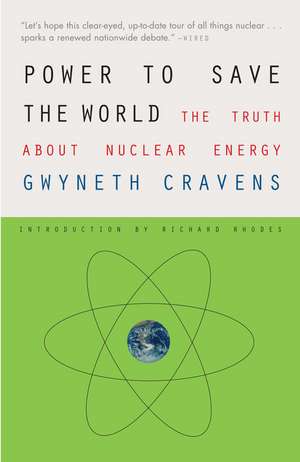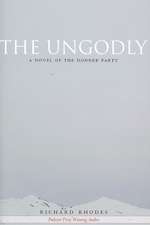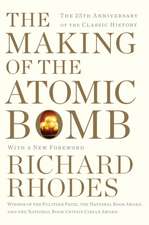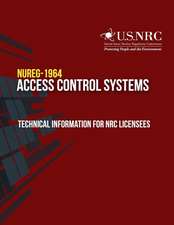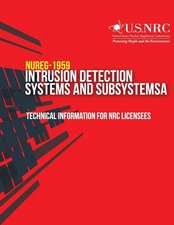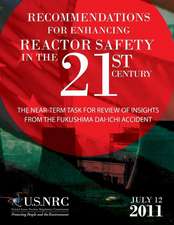Power to Save the World: The Truth about Nuclear Energy
Autor Gwyneth Cravens Introducere de Richard Rhodesen Limba Engleză Paperback – 30 sep 2008
Preț: 121.82 lei
Nou
Puncte Express: 183
Preț estimativ în valută:
23.31€ • 24.93$ • 19.44£
23.31€ • 24.93$ • 19.44£
Carte disponibilă
Livrare economică 27 martie-10 aprilie
Preluare comenzi: 021 569.72.76
Specificații
ISBN-13: 9780307385871
ISBN-10: 0307385876
Pagini: 439
Ilustrații: 19 ILLUSTRATIONS
Dimensiuni: 132 x 203 x 25 mm
Greutate: 0.45 kg
Editura: Vintage Books USA
ISBN-10: 0307385876
Pagini: 439
Ilustrații: 19 ILLUSTRATIONS
Dimensiuni: 132 x 203 x 25 mm
Greutate: 0.45 kg
Editura: Vintage Books USA
Notă biografică
Gwyneth Cravens has written about science and public health for The New York Times, Harper's, and The Washington Post. She was an editor at The New Yorker and at Harper's, and has published three novels: The Black Death, Heart's Desire, and Love and Work. This is her first work of nonfiction.
Extras
Chapter One: Survival
Images of exploding nuclear bombs gave me nightmares when I was a child. And I would often be startled awake by the roar of fighter jets splitting the sky. Were the Soviets finally attacking Albuquerque, my hometown? I’d once watched a television show about what would happen to America if the Russians bombed us—a crowd of upturned faces, a blast of white light incinerating them—then had run outside in search of cover.
Our school faced the nearby Sandia Mountains, their tall facade like a cutout made of blue construction paper. One day at recess as my best friend, Peggy Smith, and I were talking about how we loved them, she told me that she’d overheard her father, an engineer at Sandia National Laboratories who made frequent trips to the atomic test site in Nevada, tell her mother top-secret information: one of those mountains had been hollowed out and filled with thousands of atomic weapons. I pictured a vaulted cavern filled with row after row of big, white, egg-shaped bombs, looking just like the replicas of the ones dropped on Japan that were always displayed at Kirtland Air Force Base on Armed Forces Day along with a battery of real missiles pointed skyward.
When I was about eleven, I compared notes on the nuclear threat with Janet Johnson, my neighbor and pal. She had heard from some Los Alamos kids that Albuquerque was the Soviet Union’s number one target in the Western Hemisphere. That had to be because of the hollow mountain full of nuclear weapons. As every schoolchild in New Mexico knew, the first atomic bomb in the world had been tested in the southern part of the state. Janet and I paged through Life magazine’s photo spreads of the ruins of two Japanese cities, of multicolored mushroom clouds, of life-size dolls flung around in dust storms inside living rooms as houses imploded during atomic tests.
We estimated that, living as we did on the edge of town, far from the base and the labs, and on the last street before the open mesa, we’d probably survive the explosion and could save our poor parents, who downplayed the impending catastrophe to us and were not prepared for it. But we made a plan, and the preliminaries for it consumed one summer. Carrying shovels, we set out barefoot across the mesa, with its fragrant sagebrush, rippling grama grass, and cholla and prickly pear cactus, to a nearby arroyo. There we began scooping out a refuge in pinkish gravel and clay among the roots of a clump of rabbitbrush. Our mothers wouldn’t let us bring blankets or canned goods to this hole in the ground, but we did store bottles of water there as well as cloth bags we sewed and stuffed with matches, Band-Aids, packets of rice, tapioca, and tea, and knives that we carved out of bamboo that grew in my yard.
On a hot day we’d lie in the cool hollow and gaze up at the sky, with its circling hawks, big thunderheads, and fighter jets. Besides plotting our survival strategy, we read science fiction. For us the future was divided into two visions, and in discussions of them, we often used the word conceivably. We saw ourselves thriving as scientists in a prosperous utopia with atoms as a source of energy that would power our airborne cars. Wearing beautiful dresses made of miracle fabrics, we’d fly to the moon and Mars in atomic rockets piloted by our handsome husbands. At the same time we worried that World War III might reduce our country, starting with Albuquerque, to a smoldering, radioactive wasteland. Then we’d have to subsist the way humans did during the Stone Age.
If and when we felt the initial shock wave from an exploding warhead, we planned to grab our family members and pets, and run as fast as possible to our shelter. The glowing cloud would whoosh up over the city with a rumble. When the smoke and dust cleared, only a flickering crater would remain. What would be radioactive? The food in the supermarket? Maybe we’d have to take our archery sets up to the mountains and bring back game for our mothers to roast.
By the end of the summer, surveyors’ stakes had appeared on the mesa, heralding a housing development. A flash flood had swept away our hideout, and when we returned to school, boys began to loom as a much bigger concern than nuclear holocaust. Still, for many years the image of the hollow mountain visited my thoughts and appeared in my dreams.
I now live in New York, but I often fly back to New Mexico. Smog and clouds usually obscure the eastern half of the journey. When the plane angles toward the Southwest, the sky opens up and light pours down. The smooth, cultivated expanses of the Great Plains begin to give way to wrinkled tracts with occasional irrigated squares or circles of green and then fade into browns and mauves. Towering, sun-glazed thunderheads send violet shadows racing on the ground below. The landscape crumples and splits as the jetliner arcs over the vast Chihuahuan Desert. Its parched, undulating surface, barren stony ridges, salt lakes and salt pans, and meandering, branching dry riverbeds remind me that in the West, destiny is determined by geology and climate.
Soon the Sandia mountain range rears up, a giant hinge opening westward to an elevation nearly two miles above sea level, the first obvious sign that the land is tilting toward the highlands of the Continental Divide. On the approach to Albuquerque, the airliner sometimes glides over the vertical pink slabs and steep canyons that make up the western face of the Sandias. Next come foothills cut through with arroyos and dotted with scrubby piñon trees where, as a girl, I went riding on a ranch that has been transformed into a subdivision with a country club, its golf course shouldering up against the fifty thousand mostly empty acres of the military base and Sandia National Laboratories.
Access to them had always been restricted, and so had their airspace. But when I flew in one day in the mid-1990s, some time after the Berlin Wall came down, the flight path went over the base instead of skirting it. Below, for the first time, I saw what had been hidden there: widely spaced clusters of buildings, towers, ramps, and earthworks, and something unexpected: a small mountain—a foothill, really—girdled by a railroad track and ringed by three tall, concentric fences. Planed nearly clean of vegetation, shaped like a pyramid, and with several giant doors set into its flanks, this odd apparition seemed to have been transported here from Egypt’s Valley of the Kings. I realized I’d glimpsed it years earlier from horseback, my gaze dazzled by grids of steel mesh. Until now, I’d never connected Peggy’s secret with the mysterious facility I’d seen— how would a mere kid ever come upon a mountain full of nuclear weapons? Or was that just a myth?
During that particular visit to Albuquerque, I went to a gathering at the home of my oldest friends, Lili del Castillo and her husband Lewis Critchfield; they’re flamenco artists. Lew is the son of Charles Critchfield, a Los Alamos theoretical physicist who had participated in the Manhattan Project. Lew and Lili’s close friends, Rip Anderson, a scientist at Sandia National Laboratories, and his wife Marcia Fernández, an educator and a singer, were there. I knew them but not well. While others danced, sang, and played flamenco music, Rip—nobody calls him D. Richard Anderson, Ph.D., except professional journals—stayed in the background, as usual. He has curly, receding gray hair, a full mustache, and blue eyes. Wiry of build and quick of step, he favors yoked gingham or flannel shirts with mother-of-pearl snaps, faded jeans, a Stetson hat, and cowboy boots. He always seemed relaxed, but I’d found out that he was extremely observant. Of someone at a reception we’d attended, he said, “That guy spoke for about ten minutes without using any pronouns.” When Rip was four, his father, a rancher, began to teach him to be a tracker. Once as we drove at sixty miles an hour across the high desert, in answer to my questions, Rip had rapidly identified wildlife moving through his peripheral vision. He had a reputation for being able to fix anything. Lew and Lili would describe how Rip and Marcia always showed up to help whenever there was a problem, and how, during breaks from mysterious Sandia-related trips to places like Korea, Finland, and the National Academy of Sciences in Washington, D.C., he would tackle house construction, wiring, plumbing, welding, car repair, farming, and livestock wrangling. He didn’t care to talk about himself, and at parties I would try to draw him out. That’s how I found out that in his youth he’d been a rodeo contestant. At a brunch at Rip and Marcia’s I’d happened to glance out the window just as he was vaulting onto the bare back of a runaway mare. One time I was present when he and the Southwestern mystery writer Tony Hillerman compared their boyhood experiences of hand-plowing on foot behind a mule. With some wonderment at the thought, Rip realized that the two of them were part of a tiny number of Americans who still knew how to hitch up a team of horses and put them to work. Rip and Marcia were grassroots activists, tenacious crusaders for clean air and water and preservation of open land. Together with a group of volunteers, they established and maintain a wildlife sanctuary in Albuquerque.
Although I’m primarily a novelist, I’ve also written articles on scientific topics. I’d once asked Rip how the atomic clock at the National Bureau of Standards worked, but I was careful never to make inquiries about his job. In New Mexico, it’s bad manners to ask federal employees about their work or about information that might be secret. In fact, for years I wasn’t sure what my father did after he left the Forest Service to become a security-cleared civilian employed by the air force. (It turned out he inspected construction projects and surveyed the site of a new runway.) Still, I was hoping that if commercial flights could now pass through formerly restricted airspace, maybe scientists such as Rip could speak more freely.
I told him what I had seen from the air and, emboldened by the careful way he listened, asked him whether thousands of nuclear weapons were hidden in that mountain.
To my astonishment, he replied, “Sure. Bombs and warheads used to be stored there.” His manner of speaking, courteous and laconic, with the occasional archaic word thrown in, reminded me of the Old West.
“What happened to them?”
He replied, “We’re getting rid of ’em. Because of the Strategic Arms Limitation Treaties.”
“Well, I’m all for that.”
“Me, too,” he said.
“You are?”
“Heck yah. I think most of us in the nuclear end of things are.”
That gave me pause. “But how do you get rid of a nuclear warhead?”
“Take it apart.”
Even though I’d participated in ban-the-bomb rallies in Greenwich Village after I moved East to study literature in graduate school and rejoiced when the United States and the USSR called off the arms race, I’d never considered the fate of a retired weapon. “And what happens to the pieces?”
“The pits—the uranium and plutonium components—will one day be processed into fuel. The rest is carefully disposed of.”
“Bombs are being turned into fuel?” I was incredulous. “For what?”
“To make electricity.”
I don’t know which surprised me more—confirmation that the mountain had really contained bombs or the news that weapons could provide constructive power.
That was the beginning of a long dialogue and, although I could not then have imagined it, of an unexpected journey through the nuclear world with Rip as my Virgil. I came to understand that he had a mission. Trained as a chemist and oceanographer, he grasped the interconnections among the abyssal bed of the ocean, the depths of the earth, the fluctuations in global climate, the behavior of particles and energy, the inside of a nuclear reactor, and the meanderings of public policy. Conversant with deep time—the remote past and the planet ten thousand years from now—and with the universe of risk and consequence, he had acquired an international reputation in the fields of probabilistic risk assessment, environmental health, and nuclear safety. His colleagues told me that he was highly respected for his original thinking and the comprehensive sensibility he displayed when managing large programs. To this day he encourages those who work for him to do their best to make the hypothesis under scrutiny fail. Those who have worked for him tell me that this maverick imperative has made for the best science they’ve ever done— it has held up decades later—and they speak of his contribution to Big Science, his uniquely comprehensive approach to finding solutions, his unwavering respect for scientific objectivity, his status in his fields of expertise, his willingness to take unpopular stands in the scientific and technical communities, and his refusal to compromise with prevailing notions unsupported by science.
“OK, the bombs that used to scare me are going to be used for electricity,” I said that night. “But aren’t nuclear plants deadly? And can’t reactors be used to make bombs?” Worried that my daughter would be harmed, that evacuation would be impossible in case of an accident, and that my organic garden on Long Island would be contaminated by cooling tower emissions, in the 1980s I’d joined a successful campaign to prevent the opening of a new nuclear plant thirty miles from my home.
Rip quietly replied that no other technology to produce energy steadily on a large scale had a better safety record than nuclear power and emphasized that few people understood that you could make a nuclear weapon without having a reactor. “In the countries that have the bomb, civilian nuclear power plants have not been used in weapons programs. It’s not an efficient or easy way to get weapons-grade material. What you need to do that is uranium ore and a uranium enrichment plant. It’s expensive, hard to build, and it’s big, and it’s really messy. Or, if you have spent fuel from a reactor, you can reprocess it to get out the uranium and plutonium—that’s another big, dirty, complicated job that requires special equipment, and the yield from low-enriched commercial nuclear fuel is so small that it’s not worth the effort. Anyway, banning nuclear power plants will never ban bomb production. To do that, you’d have to somehow make all the technical knowledge disappear from the earth. Political restraint is what keeps countries from using bombs, not banning nuclear plants. Nuclear is the best option on the scale we need.”
From the Hardcover edition.
Images of exploding nuclear bombs gave me nightmares when I was a child. And I would often be startled awake by the roar of fighter jets splitting the sky. Were the Soviets finally attacking Albuquerque, my hometown? I’d once watched a television show about what would happen to America if the Russians bombed us—a crowd of upturned faces, a blast of white light incinerating them—then had run outside in search of cover.
Our school faced the nearby Sandia Mountains, their tall facade like a cutout made of blue construction paper. One day at recess as my best friend, Peggy Smith, and I were talking about how we loved them, she told me that she’d overheard her father, an engineer at Sandia National Laboratories who made frequent trips to the atomic test site in Nevada, tell her mother top-secret information: one of those mountains had been hollowed out and filled with thousands of atomic weapons. I pictured a vaulted cavern filled with row after row of big, white, egg-shaped bombs, looking just like the replicas of the ones dropped on Japan that were always displayed at Kirtland Air Force Base on Armed Forces Day along with a battery of real missiles pointed skyward.
When I was about eleven, I compared notes on the nuclear threat with Janet Johnson, my neighbor and pal. She had heard from some Los Alamos kids that Albuquerque was the Soviet Union’s number one target in the Western Hemisphere. That had to be because of the hollow mountain full of nuclear weapons. As every schoolchild in New Mexico knew, the first atomic bomb in the world had been tested in the southern part of the state. Janet and I paged through Life magazine’s photo spreads of the ruins of two Japanese cities, of multicolored mushroom clouds, of life-size dolls flung around in dust storms inside living rooms as houses imploded during atomic tests.
We estimated that, living as we did on the edge of town, far from the base and the labs, and on the last street before the open mesa, we’d probably survive the explosion and could save our poor parents, who downplayed the impending catastrophe to us and were not prepared for it. But we made a plan, and the preliminaries for it consumed one summer. Carrying shovels, we set out barefoot across the mesa, with its fragrant sagebrush, rippling grama grass, and cholla and prickly pear cactus, to a nearby arroyo. There we began scooping out a refuge in pinkish gravel and clay among the roots of a clump of rabbitbrush. Our mothers wouldn’t let us bring blankets or canned goods to this hole in the ground, but we did store bottles of water there as well as cloth bags we sewed and stuffed with matches, Band-Aids, packets of rice, tapioca, and tea, and knives that we carved out of bamboo that grew in my yard.
On a hot day we’d lie in the cool hollow and gaze up at the sky, with its circling hawks, big thunderheads, and fighter jets. Besides plotting our survival strategy, we read science fiction. For us the future was divided into two visions, and in discussions of them, we often used the word conceivably. We saw ourselves thriving as scientists in a prosperous utopia with atoms as a source of energy that would power our airborne cars. Wearing beautiful dresses made of miracle fabrics, we’d fly to the moon and Mars in atomic rockets piloted by our handsome husbands. At the same time we worried that World War III might reduce our country, starting with Albuquerque, to a smoldering, radioactive wasteland. Then we’d have to subsist the way humans did during the Stone Age.
If and when we felt the initial shock wave from an exploding warhead, we planned to grab our family members and pets, and run as fast as possible to our shelter. The glowing cloud would whoosh up over the city with a rumble. When the smoke and dust cleared, only a flickering crater would remain. What would be radioactive? The food in the supermarket? Maybe we’d have to take our archery sets up to the mountains and bring back game for our mothers to roast.
By the end of the summer, surveyors’ stakes had appeared on the mesa, heralding a housing development. A flash flood had swept away our hideout, and when we returned to school, boys began to loom as a much bigger concern than nuclear holocaust. Still, for many years the image of the hollow mountain visited my thoughts and appeared in my dreams.
I now live in New York, but I often fly back to New Mexico. Smog and clouds usually obscure the eastern half of the journey. When the plane angles toward the Southwest, the sky opens up and light pours down. The smooth, cultivated expanses of the Great Plains begin to give way to wrinkled tracts with occasional irrigated squares or circles of green and then fade into browns and mauves. Towering, sun-glazed thunderheads send violet shadows racing on the ground below. The landscape crumples and splits as the jetliner arcs over the vast Chihuahuan Desert. Its parched, undulating surface, barren stony ridges, salt lakes and salt pans, and meandering, branching dry riverbeds remind me that in the West, destiny is determined by geology and climate.
Soon the Sandia mountain range rears up, a giant hinge opening westward to an elevation nearly two miles above sea level, the first obvious sign that the land is tilting toward the highlands of the Continental Divide. On the approach to Albuquerque, the airliner sometimes glides over the vertical pink slabs and steep canyons that make up the western face of the Sandias. Next come foothills cut through with arroyos and dotted with scrubby piñon trees where, as a girl, I went riding on a ranch that has been transformed into a subdivision with a country club, its golf course shouldering up against the fifty thousand mostly empty acres of the military base and Sandia National Laboratories.
Access to them had always been restricted, and so had their airspace. But when I flew in one day in the mid-1990s, some time after the Berlin Wall came down, the flight path went over the base instead of skirting it. Below, for the first time, I saw what had been hidden there: widely spaced clusters of buildings, towers, ramps, and earthworks, and something unexpected: a small mountain—a foothill, really—girdled by a railroad track and ringed by three tall, concentric fences. Planed nearly clean of vegetation, shaped like a pyramid, and with several giant doors set into its flanks, this odd apparition seemed to have been transported here from Egypt’s Valley of the Kings. I realized I’d glimpsed it years earlier from horseback, my gaze dazzled by grids of steel mesh. Until now, I’d never connected Peggy’s secret with the mysterious facility I’d seen— how would a mere kid ever come upon a mountain full of nuclear weapons? Or was that just a myth?
During that particular visit to Albuquerque, I went to a gathering at the home of my oldest friends, Lili del Castillo and her husband Lewis Critchfield; they’re flamenco artists. Lew is the son of Charles Critchfield, a Los Alamos theoretical physicist who had participated in the Manhattan Project. Lew and Lili’s close friends, Rip Anderson, a scientist at Sandia National Laboratories, and his wife Marcia Fernández, an educator and a singer, were there. I knew them but not well. While others danced, sang, and played flamenco music, Rip—nobody calls him D. Richard Anderson, Ph.D., except professional journals—stayed in the background, as usual. He has curly, receding gray hair, a full mustache, and blue eyes. Wiry of build and quick of step, he favors yoked gingham or flannel shirts with mother-of-pearl snaps, faded jeans, a Stetson hat, and cowboy boots. He always seemed relaxed, but I’d found out that he was extremely observant. Of someone at a reception we’d attended, he said, “That guy spoke for about ten minutes without using any pronouns.” When Rip was four, his father, a rancher, began to teach him to be a tracker. Once as we drove at sixty miles an hour across the high desert, in answer to my questions, Rip had rapidly identified wildlife moving through his peripheral vision. He had a reputation for being able to fix anything. Lew and Lili would describe how Rip and Marcia always showed up to help whenever there was a problem, and how, during breaks from mysterious Sandia-related trips to places like Korea, Finland, and the National Academy of Sciences in Washington, D.C., he would tackle house construction, wiring, plumbing, welding, car repair, farming, and livestock wrangling. He didn’t care to talk about himself, and at parties I would try to draw him out. That’s how I found out that in his youth he’d been a rodeo contestant. At a brunch at Rip and Marcia’s I’d happened to glance out the window just as he was vaulting onto the bare back of a runaway mare. One time I was present when he and the Southwestern mystery writer Tony Hillerman compared their boyhood experiences of hand-plowing on foot behind a mule. With some wonderment at the thought, Rip realized that the two of them were part of a tiny number of Americans who still knew how to hitch up a team of horses and put them to work. Rip and Marcia were grassroots activists, tenacious crusaders for clean air and water and preservation of open land. Together with a group of volunteers, they established and maintain a wildlife sanctuary in Albuquerque.
Although I’m primarily a novelist, I’ve also written articles on scientific topics. I’d once asked Rip how the atomic clock at the National Bureau of Standards worked, but I was careful never to make inquiries about his job. In New Mexico, it’s bad manners to ask federal employees about their work or about information that might be secret. In fact, for years I wasn’t sure what my father did after he left the Forest Service to become a security-cleared civilian employed by the air force. (It turned out he inspected construction projects and surveyed the site of a new runway.) Still, I was hoping that if commercial flights could now pass through formerly restricted airspace, maybe scientists such as Rip could speak more freely.
I told him what I had seen from the air and, emboldened by the careful way he listened, asked him whether thousands of nuclear weapons were hidden in that mountain.
To my astonishment, he replied, “Sure. Bombs and warheads used to be stored there.” His manner of speaking, courteous and laconic, with the occasional archaic word thrown in, reminded me of the Old West.
“What happened to them?”
He replied, “We’re getting rid of ’em. Because of the Strategic Arms Limitation Treaties.”
“Well, I’m all for that.”
“Me, too,” he said.
“You are?”
“Heck yah. I think most of us in the nuclear end of things are.”
That gave me pause. “But how do you get rid of a nuclear warhead?”
“Take it apart.”
Even though I’d participated in ban-the-bomb rallies in Greenwich Village after I moved East to study literature in graduate school and rejoiced when the United States and the USSR called off the arms race, I’d never considered the fate of a retired weapon. “And what happens to the pieces?”
“The pits—the uranium and plutonium components—will one day be processed into fuel. The rest is carefully disposed of.”
“Bombs are being turned into fuel?” I was incredulous. “For what?”
“To make electricity.”
I don’t know which surprised me more—confirmation that the mountain had really contained bombs or the news that weapons could provide constructive power.
That was the beginning of a long dialogue and, although I could not then have imagined it, of an unexpected journey through the nuclear world with Rip as my Virgil. I came to understand that he had a mission. Trained as a chemist and oceanographer, he grasped the interconnections among the abyssal bed of the ocean, the depths of the earth, the fluctuations in global climate, the behavior of particles and energy, the inside of a nuclear reactor, and the meanderings of public policy. Conversant with deep time—the remote past and the planet ten thousand years from now—and with the universe of risk and consequence, he had acquired an international reputation in the fields of probabilistic risk assessment, environmental health, and nuclear safety. His colleagues told me that he was highly respected for his original thinking and the comprehensive sensibility he displayed when managing large programs. To this day he encourages those who work for him to do their best to make the hypothesis under scrutiny fail. Those who have worked for him tell me that this maverick imperative has made for the best science they’ve ever done— it has held up decades later—and they speak of his contribution to Big Science, his uniquely comprehensive approach to finding solutions, his unwavering respect for scientific objectivity, his status in his fields of expertise, his willingness to take unpopular stands in the scientific and technical communities, and his refusal to compromise with prevailing notions unsupported by science.
“OK, the bombs that used to scare me are going to be used for electricity,” I said that night. “But aren’t nuclear plants deadly? And can’t reactors be used to make bombs?” Worried that my daughter would be harmed, that evacuation would be impossible in case of an accident, and that my organic garden on Long Island would be contaminated by cooling tower emissions, in the 1980s I’d joined a successful campaign to prevent the opening of a new nuclear plant thirty miles from my home.
Rip quietly replied that no other technology to produce energy steadily on a large scale had a better safety record than nuclear power and emphasized that few people understood that you could make a nuclear weapon without having a reactor. “In the countries that have the bomb, civilian nuclear power plants have not been used in weapons programs. It’s not an efficient or easy way to get weapons-grade material. What you need to do that is uranium ore and a uranium enrichment plant. It’s expensive, hard to build, and it’s big, and it’s really messy. Or, if you have spent fuel from a reactor, you can reprocess it to get out the uranium and plutonium—that’s another big, dirty, complicated job that requires special equipment, and the yield from low-enriched commercial nuclear fuel is so small that it’s not worth the effort. Anyway, banning nuclear power plants will never ban bomb production. To do that, you’d have to somehow make all the technical knowledge disappear from the earth. Political restraint is what keeps countries from using bombs, not banning nuclear plants. Nuclear is the best option on the scale we need.”
From the Hardcover edition.
Recenzii
“Let's hope this clear-eyed, up-to-date tour of all things nuclear. . . . Sparks a renewed nationwide debate.”
—Wired
“Provocative. . . . A fresh look at nuclear power [that asks] whether the threat of global warming has changed the calculus of nuclear risk.”
—The Washington Post Book World
“Illuminating. . . . A picaresque, flat-out love song to the bad boy of the great American energy debate.”
—The Wall Street Journal
“Engaging and unusual.”
—Foreign Affairs
—Wired
“Provocative. . . . A fresh look at nuclear power [that asks] whether the threat of global warming has changed the calculus of nuclear risk.”
—The Washington Post Book World
“Illuminating. . . . A picaresque, flat-out love song to the bad boy of the great American energy debate.”
—The Wall Street Journal
“Engaging and unusual.”
—Foreign Affairs
